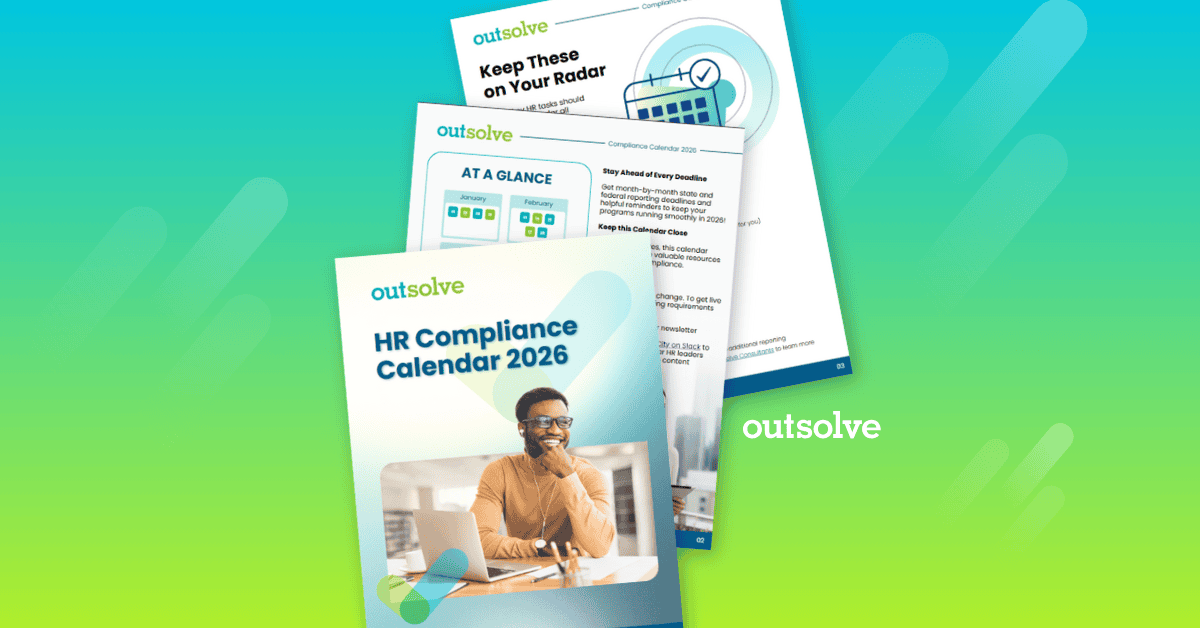
This article is part of an ongoing legal series designed to provide insight and practical guidance on current and emerging workplace compliance issues. These insights shared by lawyers are based on their interpretation of existing regulations and proposed changes, and intended for informational purposes, not to be regarded as legal advice.
Receiving a letter from ICE or the Department of Homeland Security about an upcoming Form I-9 audit can send a wave of panic through any business. Federal scrutiny can become a reality, even if you've done everything by the book. However, the more you know about the audit process, the more confidently you can prepare and respond.
The current law requires that employers verify that all new hires and rehires without an I-9 on file are legally eligible to work in the U.S. To do so, you’ll have to complete Form I-9 Employment Eligibility Verification. Instead of having employers submit Form I-9s, the government verifies employer compliance through audits. Being selected for a Form I-9 audit can be intimidating, but preparation minimizes the stress. The truth of the matter is that these audits have become more frequent, especially following the 2024 election and renewed immigration enforcement priorities under the Trump administration.
What Is a Form I-9 Audit?
In more detail, what is an I-9 audit? During an I-9 audit, the federal government reviews an employer’s records to ensure they have met their I-9 obligations. At the end of the audit process, the government determines whether the employer met their requirements or fell short. If it has fallen short, the government may impose monetary or, in extreme cases, criminal penalties.
What Are an Employer’s Form I-9 Obligations?
To comply with the law, employers must:
- Complete a Form I-9 for every employee within three days of hire.
- Retain a Form I-9 for all current employees.
- Retain Form I-9s for all former employees for at least three years after hiring or one year after the employee leaves, whichever is longer.
The I-9 process seeks to ensure that employers don’t hire anyone without work authorization, such as undocumented immigrants.
Who Performs an ICE Audit?
Immigration and Customs Enforcement (ICE), a Department of Homeland Security (DHS) branch, often performs I-9 audits. As a result, you may see an I-9 audit referred to as an ICE audit or an ICE inspection. Yet, ICE isn’t the only government agency with the right to inspect I-9s. Individuals who work for the Immigrant and Employee Rights Section (IER), which is part of the Department of Justice (DOJ), and the Department of Labor (DOL) may also initiate I-9 audits.
Possible Penalties
If the government concludes that an employer failed to meet its Form I-9 requirements, it may order penalties that require the employer to pay a fine or take actions to ensure future compliance. If the agency concludes the employer engaged in a pattern of hiring individuals without work authorization, it may initiate criminal proceedings against the business’s leadership.
Steps in the Form I-9 Audit Process
Many events can trigger the I-9 audit process, such as random selection, tips, or complaints. Anyone can provide a tip that an employer may have issues with I-9 compliance. Whether ICE investigates a single tip generally depends on the tip giver’s credibility and level of detail. Multiple tips increase the chances of an investigation.
Complaints, on the other hand, typically come from someone claiming the employer harmed them. They may be from, for example, individuals who believe they were discriminated against as noncitizens or individuals who believe they were wrongfully passed over in favor of cheaper labor from undocumented workers.
Once an audit is triggered:
- The agency notifies the employer about the audit in person or through certified mail;
- The employer compiles documents and provides them to the agency, typically due three days after receiving the notice;
- The agency reviews the documents; and
- The agency informs the employer of the results.
The agency should clearly communicate the steps the employer should take to correct errors and move forward. For example, if the agency discovers an error in an employee’s name or date of birth, it may direct the employer to correct the issue within ten days. If the agency discovers the employer has employed undocumented workers, it may order the employer to stop employing those workers.
Notice of Inspection
To begin the official I-9 audit process, ICE typically issues a Notice of Inspection (NOI) through certified mail, requesting a return receipt. It may also deliver the NOI in person.
ICE may also deliver an NOI in person as part of a workplace raid. In that case, ICE must have a warrant authorizing it to conduct the raid and search the premises. Generally, the warrant must specifically authorize ICE to view or take I-9s during the raid. If it doesn’t, the employer should still have three days to gather documents.
The NOI should identify:
- The specific documents ICE needs,
- Where to deliver the documents, and
- A deadline to provide documents.
ICE must give the employer a minimum of three days’ advanced notice.
Document Gathering for an ICE Inspection
ICE will inform the employer what Form I-9s it wants to see. The agency may want to review specific I-9s or all of the employer’s I-9s. The employer should provide copies of all requested I-9s.
ICE often also requests that employers provide:
- A copy of its payroll;
- A list of current and former employees;
- The business owner’s name, address, and social security number;
- Articles of Incorporation or other foundational documents; and
- Copies of business licenses.
If the business has any staffing agency agreements, ICE also typically requests those, too. When it requests documents, ICE should explain what format to provide them in.
Review
When ICE completes its review, it determines whether:
- The employer completed and retained all necessary Form I-9s,
- The provided Form I-9s have any errors or omissions, and
- The employees had the right to work in the U.S.
The agency may categorize issues as technical, procedural, or substantive. For example, an I-9 with an incorrect birthdate may be technical, while overlooking a single employee may be procedural. Employers receive 10 days to correct technical or procedural errors.
Failing to correct technical or procedural errors within the deadline transforms the issues into substantive issues. Substantive issues may include, for example, the employer employing individuals without work authorization.
Results of Review
After the agency completes its review, it notifies the employer of the results, which may take the form of a:
- Notice of Inspection Results. This document notifies the employer that ICE has concluded the company is in compliance. It is also called a Compliance Letter.
- Notice of Suspect Documents. This document notifies the employer that the documents an employee presented as proof of work authorization appear to be invalid.
- Notice of Discrepancies. This notice informs the employer that ICE cannot verify the employee’s work authorization and requests additional documentation.
- Notice of Technical or Procedural Failures. This statement notifies the employer of technical or procedural errors and identifies them.
- Warning Notice. This notice informs the employer that ICE identified substantive issues but expects the employer to come into compliance in the near future.
- Notice of Intent to Fine (NIF). This document notifies the employer that ICE is issuing a fine or seeking criminal penalties.
If ICE issues an NIF, the employer can request an administrative hearing to contest the agency’s determination. The employer has to make the request in writing within 30 days of receiving a NIF. During the hearing process, the employer may negotiate a settlement with ICE.
Form I-9 Audit Checklist
The following Form I-9 audit checklist can guide you through a self-audit so you’re ready to respond to an NOI as soon as you receive it. Let’s start with some general compliance guidelines. You’ll want to ensure that you have done the following:
- Completed a Form I-9 for every new employee within three days of hire,
- Retained a Form I-9 for every current employee, and
- Retained Form I-9s for every previous employee within the past three years.
Sections One and Two
Next, you’ll need your employee to fill out the first section of the form entitled Employee Information and Attestation. You’ll want to make sure that this section is complete and includes the following information:
- Employee’s accurate name,
- Employee’s accurate address,
- Employee’s accurate date of birth,
- Employee’s accurate social security number, and
- Dated signature of the employee.
Now, let’s look at the second section, entitled Employer Review and Verification. You should ensure that the section is complete and includes the following:
- Clearly identified identity documents,
- Accurate employee start date,
- Name and title of the employer’s authorized representative,
- Signed and dated by the employer’s authorized representative within the first three days of hire,
- Accurate business name, and
- Accurate business address.
Ensure that both sections are completed accurately for each employee and former employee.
Supplemental Sections
Next, you’ll need to complete Supplement A, which is entitled Preparer and/or Translator Certification, if required. This form is necessary if a translator or preparer assisted in filling out the form. You’ll also want to check for the following:
- Accurate name,
- Accurate address,
- Accurate date of birth, and
- Dated signature of all preparers or translators.
Additionally, you’ll need to identify if you need to complete Supplement B in the future, which is entitled Reverification and Rehire. This step is necessary if the employee needs to be verified again, is rehired within three years, or changes their name. Look for:
- Accurate employee name,
- Accurate name of the employer’s representative, and
- The dated signatures of the employer’s representative.
If the employee requires reverification, you will need to ensure that the:
- An ID document is identified,
- The ID document number is accurate,
- The ID document expiration date is accurate, and
- Date of birth is accurate.
If the employee is a rehire, you’ll need to include the correct rehire date. If the employee has had a change of name, you will want to include the accurate new name.
Let Us Help You Prepare for an Audit
With the resurgence of worksite enforcement under the 2025 Trump administration, Form I-9 audits are on the rise, and unprepared businesses face real risks. OutSolve’s team of consultants can help you identify vulnerabilities, correct issues before auditors do, and build a defensible Form I-9 process. Contact us to take a proactive approach to compliance and protect your business.
Founded in 1998, OutSolve has evolved into a premier compliance-driven HR advisory firm, leveraging deep expertise to simplify complex regulatory landscapes for businesses of all sizes. With a comprehensive suite of solutions encompassing HR compliance, workforce analytics, and risk mitigation consulting, OutSolve empowers organizations to navigate the intricate world of employment regulations with confidence.
Weekly OutLook
Featured Posts

New Year, New Deadlines: 2026 HR Compliance Calendar

outRageous HR: Plan Now or Pay Later
Related Posts

In-House or Outsourced I-9 Management: Which Is Best for Your Organization?
Every U.S. employer, regardless of size or industry, is required by law to confirm each new hire’s identity and verify that they are authorized to...

outRageous HR: Building a Compensation Strategy That Actually Works
If your compensation strategy is mostly “gut feeling” plus whatever you did last year… it’s time to rethink your approach.

HR Compliance Checklist: What Every HR Pro Needs to Know
During times of sweeping change to federal laws, and with new state laws being enacted, it's more important than ever for HR professionals to ensure...

